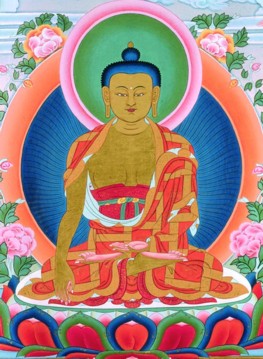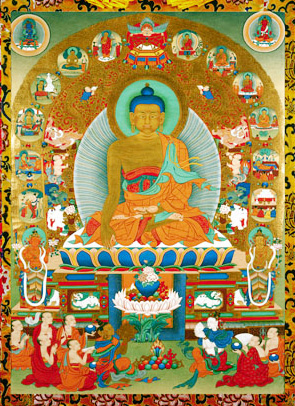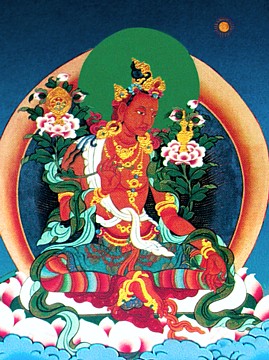Buddha: Difference between revisions
No edit summary |
No edit summary |
||
| (18 intermediate revisions by 4 users not shown) | |||
| Line 1: | Line 1: | ||
[[Image:BuddhaSmall.jpg| | [[Image:BuddhaSmall.jpg|thumb|[[Buddha Shakyamuni]]]] | ||
'''Buddha''' | '''Buddha''' (Skt.; Tib. [[སངས་རྒྱས་]], ''Sangyé'', [[Wyl.]] ''sangs rgyas''), usually refers to [[Shakyamuni Buddha]], the Indian prince Gautama Siddhartha, who reached [[enlightenment]] in the sixth century B.C., and who taught the spiritual path followed by millions all over Asia, known today as [[Buddhism]]. Buddha, however, also has a much deeper meaning. It means anyone who has completely awakened from [[ignorance]] and opened to his or her vast potential for [[wisdom]]. A buddha is one who has brought a final end to [[suffering]] and frustration and discovered a lasting and deathless happiness and peace. | ||
The Tibetan term for Buddha, ''Sangyé'', is explained as follows | ==Etymology== | ||
The Tibetan term for Buddha, སངས་རྒྱས་, ''Sangyé'', is explained as follows: | |||
''Sang'' means ‘awakening’ from the sleep of ignorance, and ‘purifying’ the darkness of both [[emotional obscurations]] and [[cognitive obscurations]]. | :སངས་, ''Sang'' means ‘awakening’ from the sleep of ignorance, and ‘purifying’ the darkness of both [[emotional obscurations]] and [[cognitive obscurations]]. | ||
''Gyé'' means ‘opening’, like a blossoming lotus flower, to all that is knowable, and ‘developing’ the [[wisdom of omniscience]]—the knowledge of the true nature of things, just as they are, and the | :[[རྒྱས་པ་|རྒྱས་]], ''Gyé'' means ‘opening’, like a blossoming lotus flower, to all that is knowable, and ‘developing’ the [[wisdom of omniscience]]—the knowledge of the true nature of things, just as they are, and the knowledge of all things in their multiplicity. | ||
knowledge of all things in their multiplicity. | |||
===Eight Qualities of | The ''[[Seventy Verses on Taking Refuge]]'' says: | ||
The qualities of | |||
:One who sleeps no more in ignorance, | |||
:And in whom genuine wisdom is brought forth, | |||
:Has truly awoken as an awakened buddha, | |||
:Just as one wakes from ordinary sleep. | |||
As it says, ‘awakened’ means that ending the slumber of ignorance is like waking from sleep. And: | |||
:Their minds have opened to all that is knowable, | |||
:And they have overcome the tight seal of delusion, | |||
:So the awakened have blossomed like lotus flowers. | |||
As it says, they are like ‘blossoming’ lotus petals in the sense that through their genuine wisdom they have overcome the tendency to ‘shut down’ through lack of knowledge, and their minds are open to all that can be known. | |||
==Kayas & Wisdoms== | |||
[[Image:Samantabhadra.jpg|thumb|The [[Dharmakaya]] Buddha [[Samantabhadra]]]] | |||
Buddhas are spoken of in terms of the kayas and wisdoms. | |||
===Three Kayas=== | |||
#[[dharmakaya]], | |||
#[[sambhogakaya]] and | |||
#[[nirmanakaya]]. | |||
The three 'bodies' of a [[buddha]]. They relate not only to the truth in us, as three aspects of the true [[nature of mind]], but to the truth in everything. Everything we perceive around us is nirmanakaya; its nature, light or energy is sambhogakaya; and its inherent truth, the dharmakaya. | |||
===Five Wisdoms=== | |||
#[[wisdom of dharmadhatu]] | |||
#[[mirror-like wisdom]] | |||
#[[wisdom of equality]] | |||
#[[wisdom of discernment]] | |||
#[[all-accomplishing wisdom]] | |||
[[Sogyal Rinpoche]] writes: | |||
:You can also think of the [[nature of mind]] like a mirror, with five different powers or 'wisdoms.' Its openness and vastness is the '''wisdom of all-encompassing space''' [or dharmadhatu], the womb of compassion. Its capacity to reflect in precise detail whatever comes before it is the '''mirror-like wisdom'''. Its fundamental lack of any bias toward any impression is the '''equalizing wisdom''' [or wisdom of equality]. Its ability to distinguish clearly, without confusing in any way the various different phenomena that arise, is the '''wisdom of discernment'''. And its potential of having everything already accomplished, perfected, and spontaneously present is the '''all-accomplishing wisdom'''. <ref>''[[The Tibetan Book of Living and Dying]]'', p. 157</ref> | |||
These five wisdoms may be condensed into '''two''': | |||
*‘the wisdom that knows the nature of all phenomena’ which comprises the wisdom of the dharmadhatu, mirror-like wisdom and the wisdom of equality; and | |||
*‘the wisdom that knows the multiplicity of phenomena’ which comprises discriminating and all-accomplishing wisdom. | |||
They can all be condensed into a '''single''' wisdom: the [[wisdom of omniscience]]. | |||
==Twelve Deeds== | |||
[[Image:Buddha12deeds.jpg|thumb|The [[Twelve deeds]] of a Buddha]] | |||
Supreme nirmanakaya buddhas display the [[twelve deeds]]: | |||
#the descent from [[Tushita]], the Joyous pure land (''dga' ldan gyi gnas nas 'pho ba''), | |||
#entering the mother’s womb (''lhums su zhugs pa''), | |||
#taking birth<ref>In the case of Buddha Shakyamuni, this was in the [[Lumbini]] garden.</ref> (''sku bltams pa''), | |||
#becoming skilled in various arts (''bzo yi gnas la mkhas pa''), | |||
#delighting in the company of royal consorts (''btsun mo'i 'khor dgyes rol ba''), | |||
#developing renunciation and becoming ordained (''rab tu byung ba''), | |||
#practicing austerities for six years (''dka' ba spyad pa''), | |||
#proceeding to the foot of the [[bodhi tree]] (''byang chub snying por gshegs pa''), | |||
#overcoming [[Mara]]’s hosts (''bdud btul ba''), | |||
#becoming fully [[enlightenment|enlightened]] (''mngon par rdzogs par sangs rgyas pa''), | |||
#turning the wheel of [[Dharma]] (''chos kyi 'khor lo bskor ba''), and | |||
#passing into [[parinirvana|mahaparinirvana]] <ref>In the case of Buddha Shakyamuni, this was in the city of [[Kushinagara]].</ref> (''mya ngan las 'das pa'') | |||
==Qualities== | |||
===Eight Qualities of a Buddha=== | |||
[[Image:Maitreya.jpg|thumb|[[Maitreya]], the future Buddha]] | |||
The qualities of a Buddha are immeasurable. Yet according to [[Maitreya]]'s ''[[Uttaratantra Shastra]]'', they can be condensed in eight qualities of the [[two-fold benefit]] of self and others: | |||
Benefit of self:<br> | Benefit of self:<br> | ||
| Line 23: | Line 84: | ||
And 7) the benefit of self and 8) the benefit of others. | And 7) the benefit of self and 8) the benefit of others. | ||
==How a Buddha Teaches== | |||
When the teacher is a fully enlightened buddha, he teaches through his [[Three Types of Miraculous Ability | three types of miraculous ability]]. <ref>[[Patrul Rinpoche]], ''Preliminary Points To be Explained when Teaching the Buddha's Word or the Treatises'', translated by Adam Pearcey.</ref> | |||
==Notes== | |||
<small><references/></small> | |||
==Teachings Given to the [[About Rigpa|Rigpa]] Sangha== | |||
*[[Philippe Cornu]], Paris, France, 4 November 2019 | |||
==Further Reading== | |||
*[[Khenpo Ngawang Palzang]], ''[[A Guide to the Words of My Perfect Teacher]]'', Shambhala, 2004, pages 101-107. | |||
==Internal Links== | |||
*[[1002 buddhas of this Fortunate Aeon]] | |||
*[[Buddhas of the five families]] | |||
*[[Three kayas]] | |||
==External Links== | |||
*[https://www.siddharthasintent.org/resources/recordings/Siddhartha-Festival-The-Buddha A teaching on ''The Buddha'' by Dzongsar Khyentse Rinpoche, during the Siddhartha Festival in Bodhgaya, India, 2016] | |||
[[Category:Key Terms]] | [[Category:Key Terms]] | ||
[[Category:Buddhas and Deities]] | [[Category:Buddhas and Deities]] | ||
[[Category:Three Jewels]] | |||
[[Category: Sanskrit Terms]] | |||
Latest revision as of 19:51, 27 January 2022

Buddha (Skt.; Tib. སངས་རྒྱས་, Sangyé, Wyl. sangs rgyas), usually refers to Shakyamuni Buddha, the Indian prince Gautama Siddhartha, who reached enlightenment in the sixth century B.C., and who taught the spiritual path followed by millions all over Asia, known today as Buddhism. Buddha, however, also has a much deeper meaning. It means anyone who has completely awakened from ignorance and opened to his or her vast potential for wisdom. A buddha is one who has brought a final end to suffering and frustration and discovered a lasting and deathless happiness and peace.
Etymology
The Tibetan term for Buddha, སངས་རྒྱས་, Sangyé, is explained as follows:
- སངས་, Sang means ‘awakening’ from the sleep of ignorance, and ‘purifying’ the darkness of both emotional obscurations and cognitive obscurations.
- རྒྱས་, Gyé means ‘opening’, like a blossoming lotus flower, to all that is knowable, and ‘developing’ the wisdom of omniscience—the knowledge of the true nature of things, just as they are, and the knowledge of all things in their multiplicity.
The Seventy Verses on Taking Refuge says:
- One who sleeps no more in ignorance,
- And in whom genuine wisdom is brought forth,
- Has truly awoken as an awakened buddha,
- Just as one wakes from ordinary sleep.
As it says, ‘awakened’ means that ending the slumber of ignorance is like waking from sleep. And:
- Their minds have opened to all that is knowable,
- And they have overcome the tight seal of delusion,
- So the awakened have blossomed like lotus flowers.
As it says, they are like ‘blossoming’ lotus petals in the sense that through their genuine wisdom they have overcome the tendency to ‘shut down’ through lack of knowledge, and their minds are open to all that can be known.
Kayas & Wisdoms

Buddhas are spoken of in terms of the kayas and wisdoms.
Three Kayas
The three 'bodies' of a buddha. They relate not only to the truth in us, as three aspects of the true nature of mind, but to the truth in everything. Everything we perceive around us is nirmanakaya; its nature, light or energy is sambhogakaya; and its inherent truth, the dharmakaya.
Five Wisdoms
- wisdom of dharmadhatu
- mirror-like wisdom
- wisdom of equality
- wisdom of discernment
- all-accomplishing wisdom
Sogyal Rinpoche writes:
- You can also think of the nature of mind like a mirror, with five different powers or 'wisdoms.' Its openness and vastness is the wisdom of all-encompassing space [or dharmadhatu], the womb of compassion. Its capacity to reflect in precise detail whatever comes before it is the mirror-like wisdom. Its fundamental lack of any bias toward any impression is the equalizing wisdom [or wisdom of equality]. Its ability to distinguish clearly, without confusing in any way the various different phenomena that arise, is the wisdom of discernment. And its potential of having everything already accomplished, perfected, and spontaneously present is the all-accomplishing wisdom. [1]
These five wisdoms may be condensed into two:
- ‘the wisdom that knows the nature of all phenomena’ which comprises the wisdom of the dharmadhatu, mirror-like wisdom and the wisdom of equality; and
- ‘the wisdom that knows the multiplicity of phenomena’ which comprises discriminating and all-accomplishing wisdom.
They can all be condensed into a single wisdom: the wisdom of omniscience.
Twelve Deeds

Supreme nirmanakaya buddhas display the twelve deeds:
- the descent from Tushita, the Joyous pure land (dga' ldan gyi gnas nas 'pho ba),
- entering the mother’s womb (lhums su zhugs pa),
- taking birth[2] (sku bltams pa),
- becoming skilled in various arts (bzo yi gnas la mkhas pa),
- delighting in the company of royal consorts (btsun mo'i 'khor dgyes rol ba),
- developing renunciation and becoming ordained (rab tu byung ba),
- practicing austerities for six years (dka' ba spyad pa),
- proceeding to the foot of the bodhi tree (byang chub snying por gshegs pa),
- overcoming Mara’s hosts (bdud btul ba),
- becoming fully enlightened (mngon par rdzogs par sangs rgyas pa),
- turning the wheel of Dharma (chos kyi 'khor lo bskor ba), and
- passing into mahaparinirvana [3] (mya ngan las 'das pa)
Qualities
Eight Qualities of a Buddha

The qualities of a Buddha are immeasurable. Yet according to Maitreya's Uttaratantra Shastra, they can be condensed in eight qualities of the two-fold benefit of self and others:
Benefit of self:
1) Self-arisen wisdom
2) Unconditioned body
3) Spontaneously perfect
Benefit of others:
4) Knowledge
5) Love
6) Power
And 7) the benefit of self and 8) the benefit of others.
How a Buddha Teaches
When the teacher is a fully enlightened buddha, he teaches through his three types of miraculous ability. [4]
Notes
- ↑ The Tibetan Book of Living and Dying, p. 157
- ↑ In the case of Buddha Shakyamuni, this was in the Lumbini garden.
- ↑ In the case of Buddha Shakyamuni, this was in the city of Kushinagara.
- ↑ Patrul Rinpoche, Preliminary Points To be Explained when Teaching the Buddha's Word or the Treatises, translated by Adam Pearcey.
Teachings Given to the Rigpa Sangha
- Philippe Cornu, Paris, France, 4 November 2019
Further Reading
- Khenpo Ngawang Palzang, A Guide to the Words of My Perfect Teacher, Shambhala, 2004, pages 101-107.